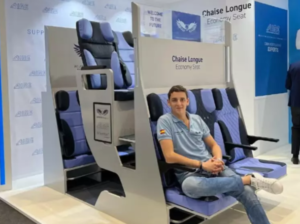Airbus is currently exploring an innovative yet contentious seating arrangement known as the Chaise Longue Economy Seat project, which proposes a double-decker configuration within the aircraft cabin. This design, conceptualized by aviation entrepreneur Alejandro Núñez Vicente, aims to optimize cabin space by introducing two levels of seats, potentially transforming the traditional economy class experience.
Design Overview
The Chaise Longue design eliminates overhead storage compartments to accommodate a two-tier seating structure. Passengers can choose between upper and lower seats: the lower level offers increased legroom, while the upper tier provides greater recline angles and space for stretching. Access to the upper seats is facilitated by a small set of steps, reminiscent of a bunk bed setup. Instead of overhead bins, luggage would be stored beneath the seats, altering the conventional storage approach.
Collaboration with Airbus
In a significant development, Airbus has engaged in early-stage discussions with Núñez Vicente to explore the feasibility of integrating the Chaise Longue seating concept into their commercial aircraft. An Airbus representative confirmed the collaboration, stating that they are “exploring some early stage concepts with Airbus on two-level seating solutions for Airbus commercial aircraft.” While specific details and timelines remain undisclosed, this partnership indicates a serious consideration of the double-decker seating arrangement by a major industry player.
Industry Implications
The introduction of a double-decker seating configuration could have profound implications for the aviation industry. For airlines, this design offers the potential to maximize passenger capacity without expanding the aircraft’s physical dimensions, potentially leading to increased revenue per flight. From a passenger perspective, the promise of enhanced legroom and recline options addresses common comfort concerns associated with economy class travel. However, the design’s departure from traditional seating arrangements may require passengers to adjust to a new in-flight experience.
Public Reception and Criticism
Public reaction to the Chaise Longue concept has been mixed. Critics have raised concerns about safety, evacuation procedures, and the potential for increased discomfort, particularly for passengers seated in the lower tier who might feel confined. Social media platforms have seen a range of responses, from skepticism about the practicality of the design to humorous remarks about the proximity of passengers. Núñez Vicente acknowledges these criticisms but emphasizes that innovation often faces initial resistance. He believes that continued development and exposure will help mitigate concerns and demonstrate the design’s viability.
Future Prospects
While the collaboration between Airbus and Chaise Longue is in its nascent stages, the exploration of double-decker seating reflects a broader trend in the aviation industry toward reimagining cabin layouts to enhance efficiency and passenger comfort. The successful implementation of such a design would require rigorous testing to meet safety standards, as well as careful consideration of passenger experience. As airlines strive to balance profitability with customer satisfaction, innovative seating solutions like the Chaise Longue may play a pivotal role in the future of air travel.
In conclusion, Airbus’s investigation into the Chaise Longue double-decker seating design signifies a bold step toward redefining economy class travel. While challenges and criticisms persist, the potential benefits of increased capacity and improved passenger comfort make this an endeavor worth watching as it progresses through development and testing phases.


